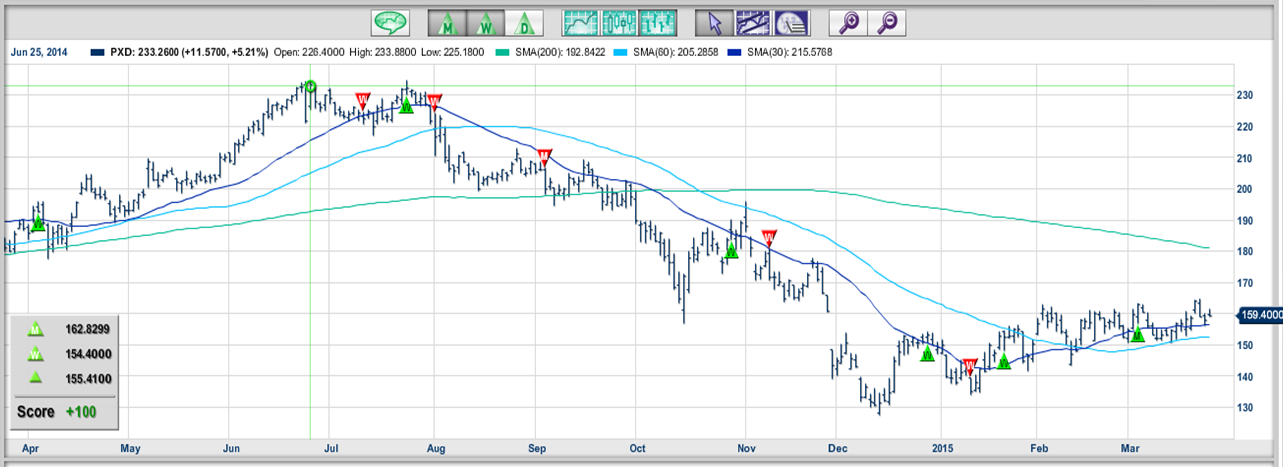
One stock that has caught my attention the last couple months has been Pioneer Natural Resources (PXD).
Simply put, every analyst or article I've read agrees PXD has a solid balance sheet, exceptional management, favorable hedging positions through 2016, low production costs, and some of the most productive oil field acreage in the business. Plus, the stock seems to be trending higher within a trading channel that bears the appearance of a good strong bottoming formation – even while trading more than 30% below its 52-week high.
U.S. Shale Oil
Shale is still a dangerous place to play, no doubt about it. Oil and gas prices continue to flirt with a continuation of their precipitous declines since last June 20th. Further oil-price deterioration would surely affect shale companies like PXD.
On the other hand, if you're game for a little bottom-fishing and want to stay with high quality, take a look at Pioneer.
PXD showing a nice bottoming pattern
PXD's pre-crash high was around $233 per share. The stock's correction over the ensuing months, not surprisingly, has coincided with falling oil prices. Its 52-week low occurred in mid-December at about $127. Currently, PXD trades around $160.
Importantly, note that much of PXD's "bottoming" process has occurred despite continued oil price declines in mid-January, as well as throughout February and March. This is a good indication of the PXD's underlying strategic and financial position, as well as the stock's oversold status, in my view. Investor sentiment for PXD is apparently healthy, for the time being. Of course (again), falling crude prices, should that occur, may affect analyst estimates, eventually impacting PXD stock's performance.

What's PXD management doing now?
PXD is a major player in several Texas oil fields, as well as others in Colorado, Kansas, and Alaska. Besides significant production in the Eagle Ford Shale and Barnett Shale, PXD is having success in Spraberry and Wolfcamp shale formations in West Texas's Midland Basin (a part of the larger Permian). PXD is the largest producer and landowner in Spraberry/Wolfcamp and believes the property to be the largest onshore oil field in the U.S. Presently, the company is exploring 825,000 acres there, using 100% horizontal drilling and fracking techniques. S&P Capital IQ calls Spraberry/Wolfcamp a likely "major catalyst" for PXD's production in 2015-2016. PXD calls the fields "game-changing."
PXD is highly focused on productive, lower-cost wells, both via acquisition of assets meeting that description and also via selling off assets – such as its former Argentina, Tunisia, and South Africa holdings – when capital costs rise and/or drilling results become less fruitful.
Management has slashed its planned capex by about 45% in 2015, including termination of its vertical drilling program, according to S&P Capital IQ. Still, 2015 planned capex for drilling alone stands at about $1.6 Billion. PXD is sitting on more than 11 Billion Barrels of Oil Equivalent (BBOE), about 70% of which is oil and natural gas liquids (and about 30% of which is gas). PXD has indicated an intention to be patient with adding more rigs in its oil fields, but has a willingness to ramp up if and when margins improve. As it stands today, PXD estimates its production growth is very likely to exceed 10% in 2015. S&P projects 18%, citing the firm's historical tendency to hit the high end of its projected range. We’ll see if 2015 might be different – perhaps by design?
In its March 24, 2015 investor presentation, PXD describes its "strong financial flexibility" as follows:
"Strong balance sheet, strong derivatives position and planned EFS Midstream sale provide Pioneer with the financial flexibility to prudently manage through a protracted oil price downturn or quickly ramp up drilling activity if margins improve significantly."
More about PXD stock
PXD's aforementioned investor presentation boasts that its stock has been the best performing exploration and production (E&P) stock in S&P 500 and versus all peers since 2010. S&P Capital IQ reports that $10,000 invested 5 years ago would presently be worth over $30,000.
Best,
Adam Feik
INO.com Contributor - Energies
Disclosure: This contributor does not own any stocks mentioned in this article. This article is the opinion of the contributor themselves. The above is a matter of opinion provided for general information purposes only and is not intended as investment advice. This contributor is not receiving compensation (other than from INO.com) for their opinion.
